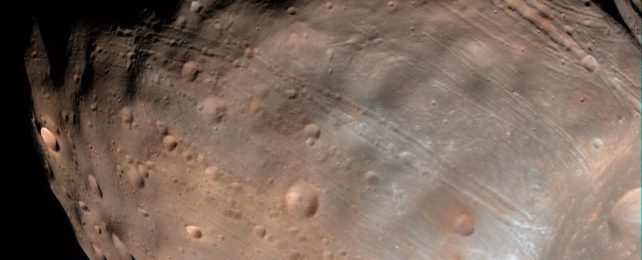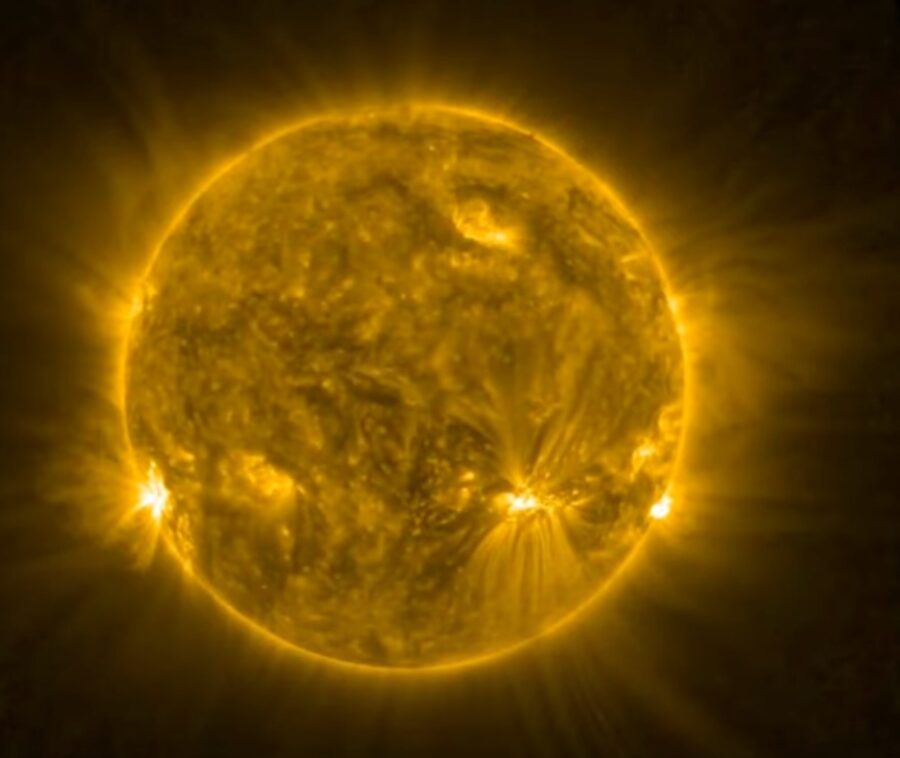The Strange Mystery of Phobos' Tiger Stripes May Finally Be Solved

Image of Phobos taken by the Mars Reconnaissance Orbiter.
Martian moon Phobos is not long for this Universe.
According to astronomers' calculations, the potato-shaped satellite is drawing slowly, but inexorably, closer to its host planet. Eventually, within about 100 million years, the gravitational interaction between the two bodies will tear Phobos apart, giving the red planet a temporary dusty ring.
According to a new study, those gravitational interactions may already be having an observable effect. At least some of the mysterious, parallel shallow grooves that cover the moon's entire surface could be the result of fracturing as its orbit slowly decays and tidal forces tug ever harder at its bones.
"Our analysis supports a layered heterogeneous structure for Phobos with possible underlying failure-induced fractures, as the precursor of the eventual demise of the de-orbiting satellite," write a team of astronomers led by Bin Cheng of Tsinghua University in China and the University of Arizona.
Tidal forces that pull on bodies in a system are the result of their gravitational interaction, stretching their structures along an axis that runs between them.
Usually, any significant effect this distortion might have on a solid surface is pretty small. Where tidal forces can be easily observed in the movements of our planet's liquid oceans, visible effects on masses of land are less obvious.
That doesn't mean tidal forces between other solid bodies can't have more obvious consequences. Stretching caused by tidal forces can in some cases cause stress fracturing. We've seen this in Saturn's moon Enceladus, whose icy shell has deep, parallel fractures at its south pole caused by tidal stress.
With an orbit of just 7 hours and 39 minutes, Phobos is pretty close to Mars, drawing closer at a rate of around 1.8 centimeters per year. At that proximity, it's absolutely possible that tidal forces could induce surface fracturing on its 27 kilometer- (16.8 mile-) wide body. The idea that Phobos' stripes are the result of such an interaction has also been previously considered and found plausible.
However, it's unclear whether the current configuration and interaction of Phobos and Mars could produce the observed striping, and other explanations are also in the running. For instance, a 2018 study found that the stripes could be the result of rolling boulders.
So Cheng and his colleagues conducted 3D mathematical modeling explicitly examining the tidal stretching and squeezing of a layered Phobos-like body, with a loose rubbly exterior sitting over a cohesive layer below.
The researchers performed hundreds of simulations using their model. In a significant number of these simulations, tidal forces caused the cohesive layer to split and fracture in parallel grooves, causing the upper loose regolith to drain into the fractures below. The result is a stripey, striated surface very similar to regions observed on Phobos.
Not all areas of Phobos were consistent with the model, the team found. In particular, grooves around the moon's equator didn't match predictions. But the results do show that at least some of the stripes could be caused by fracturing as the moon spirals towards death by tidal disembowelment. This would mean that we are seeing the beginning of the end for Phobos.
These results, therefore, could have implications for studying other moons that are experiencing significant orbital decay, such as Neptune's moon Triton. The draining rubble could also expose pristine material on Phobos, could make the grooves a very interesting region of study for the upcoming Mars moon mission by the Japanese Space Agency.
This mission is expected to deliver conclusive evidence of the origin of these mysterious stripes – but tidal disruption is certainly appearing to be an intriguing possibility.
"Modeling Phobos as a rubble-pile interior overlaid by a cohesive layer, we find that the tidal strain could create parallel fissures with regular spacing," the researchers write in their paper.
"Our analysis suggests that some of the grooves lining the surface of Phobos are likely early signs of the eventual demise of the de-orbiting satellite."
Mashed potato, anyone?
The research has been published in The Planetary Science Journal.
Mystery Of How Mars’s Doomed Moon Got
Its Stripes May Have Been Solved
So long, Phobos, and thanks for all the fissures.
KATY EVANS
Managing Editor
Nov 18, 2022

A few theories have been forward for what caused the strange stripes on Phobos, snapped here by NASA's Mars Reconnaissance Orbiter in 2008.
There are many mysterious things about Mars’s doomed moon Phobos. We don’t know where it came from, what’s inside it, what the strange straight lines on its surface are, and it’s possibly in the process of being ripped apart by Mars. In fact, according to a new paper, that’s what’s causing Phobos’s weird tiger stripes.Top StoriesREAD MORLab-Grown Meat Just Took Another Step Closer ToOur Shelves
We know it’s going to die one day, probably in around 50 million years – the question is, how? Astronomers have discovered that the unusual parallel grooves covering the surface, thought to probably be the results of some ancient impact, are actually canyons full of dust that are growing wider as the extreme gravitational forces between moon and planet tear it apart.
Both of Mars’s moons are ominously named after the twin sons of Mars, the Roman god of war: Phobos, the larger of the two, for the god of fear and panic; and Deimos, the smaller, for his brother, the god of dread and terror. The reason Phobos is known as Mars’s “doomed “ moon, however, is that the satellite is caught in a death spiral around Mars, slowly falling towards the Red Planet at 1.8 centimeters (0.7 inches) every year (which is faster than Venice is sinking) until they eventually collide.
Both of Mars’s moons are tidally locked to the planet, meaning they always present the same face toward Mars. Tidal forces that pull on objects in space are due to their gravitational interactions and can have observable effects, like the effect the gravitational pull of the Moon has on Earth’s water in the form of tides.
Visible effects on the solid surface of objects in space, however, are usually pretty small. That’s not to say it doesn’t occur – the icy shell of Saturn’s moon Enceladus is covered in stress fractures from the tidal pull of its giant planet.
Orbiting Mars in just 7 hours and 39 minutes, Phobos is pretty close to Mars, making it plausible the tidal forces are causing the surface fracturing of the small moon. This idea has even been put forward before. Orbiting so near puts Phobos closer and closer to the Roche limit, the place where gravitational forces will pull any solid orbiting object apart. This occurs because the gravity on the planet-facing side is so much larger than on the other side it can't stay in one piece. Eventually, Phobos will be destroyed, forming a smaller version of Saturn's rings around Mars.
Alternative hypotheses have been put forward too. In 2018 it was suggested bouncing boulders carved the grooves on Phobos's surface.
In the new study, the team performed hundreds of simulations using a 3D mathematical model of a Phobos-like object, looking into the stretching and squeezing that occurs from tidal forces within a Phobos-like orbit. They found that by modeling Phobos as a "rubble-pile interior overlaid with a cohesive layer" many of the simulations created evenly spaced parallel fissures like the ones seen on the Martian moon.
“Fracture opening triggers drainage of upper loose material into these deep-seated valleys, which we show could lead naturally to the formation of groove-like structures,” they wrote.
Not all regions of Phobos matched the simulations – the grooves around its equator weren't explained by their predictions, for example. However, the findings do suggest that some (or even most) of the stripes are being caused by tidal fracturing as the moon continues on its doomed path to Mars collision.
All this makes for an intriguing target for the Japanese Space Agency's 2024 Martian Moons eXploration (MMX) mission to land spacecraft on both Phobos and Deimos, returning samples in 2029. We might even be able to witness the beginning of the end of Phobos.
The study is published in The Planetary Science Journal.


:format(webp)/cdn.vox-cdn.com/uploads/chorus_asset/file/12861713/setienne_180906_2930_00295.jpg)





















